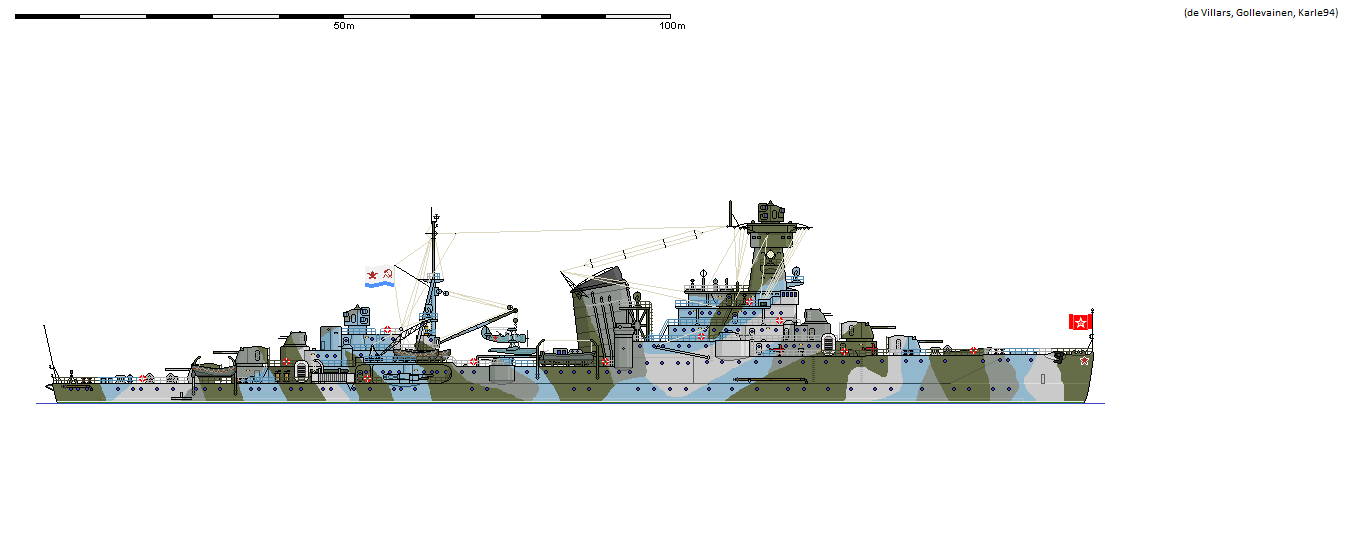Z krążowników typu Swietłana pod koniec lat 30-tych nieukończony w jakiejkolwiek formie pozostał już tylko jeden – Admirał Butakow. Przez lata stał bez celu, stopniowy rozbierany na części zamienne dla pozostałych jednostek. W 1928 r. przemianowano go na Woroszyłow, ale nic to w losach jednostki nie zmieniło. Dopiero na przełomie 1939 i 1940 r. pojawił się ciekawy pomysł przebudowy na krążownik z funkcją okrętu szkolnego (projekt 78), uzbrojony w 8 dział kal. 130 mm w podwójnych wieżach typu B-2LM, 8 dział kal. 76 mm w stanowiskach typu 39-K, 8 działek kal. 37 mm w dwóch poczwórnych stanowiskach typu 46-K, 8 km-ów 12,7 mm oraz 2 potrójne wyrzutnie torped kal. 533 mm. Miał też zabierać 20 bomb głębinowych, ale nie wiadomo w jaki sposób miały być używane – ja przyjąłem że wystrzeliwane przez 2 miotacze typu BMB-1. Na pokładzie w części rufowej miały znajdować się tory minowe, ale brak informacji o zabieranej ilości min. Okręt miał otrzymać także zupełnie nowe nadbudówki i duży pojedynczy komin. Prawdopodobnie zupełnie nowy miał być też układ napędowy, pozwalający uzyskać prędkość 28 w. i zasięg 4000 Mm przy 14 w. Jako okręt szkolny miałby zabierać na pokład 90 słuchaczy Akademii i 220 kursantów (takie znalazłem rozróżnienie). Z dostępnego rysunku wynika, iż na śródokręciu, pod pokładem miał być zlokalizowany hangar dla wodnosamolotu, przenoszonego na wodę za pomocą dźwigu na rufowym maszcie. Po modernizacji okręt miał ponoć otrzymać nazwę Awrora. W mojej wizji okręt po przebudowie prezentuje się następująco:
Awrora, soviet training cruiser laid down 1913 (Engine 1941)
Displacement:
6 258 t light; 6 472 t standard; 6 806 t normal; 7 074 t full load
Dimensions: Length overall / water x beam x draught
519,55 ft / 513,19 ft x 50,49 ft x 18,24 ft (normal load)
158,36 m / 156,42 m x 15,39 m x 5,56 m
Armament:
8 - 5,12" / 130 mm guns (4x2 guns), 67,03lbs / 30,40kg shells, 1936 Model
Quick firing guns in deck mounts with hoists
on centreline ends, evenly spread, 2 raised mounts - superfiring
8 - 2,99" / 76,0 mm guns (4x2 guns), 13,39lbs / 6,07kg shells, 1939 Model
Anti-aircraft guns in deck mounts with hoists
on side, all amidships, 2 raised mounts - superfiring
8 - 1,46" / 37,0 mm guns (2x4 guns), 1,55lbs / 0,70kg shells, 1938 Model
Anti-aircraft guns in deck mounts with hoists
on centreline ends, evenly spread, all raised mounts
8 - 0,50" / 12,7 mm guns (4x2 guns), 0,06lbs / 0,03kg shells, 1938 Model
Machine guns in deck mounts
on side ends, evenly spread, all raised mounts - superfiring
Weight of broadside 656 lbs / 298 kg
Shells per gun, main battery: 200
6 - 21,0" / 533 mm above water torpedoes
Armour:
- Belts: Width (max) Length (avg) Height (avg)
Main: 2,95" / 75 mm 460,99 ft / 140,51 m 6,99 ft / 2,13 m
Ends: Unarmoured
Main Belt covers 138% of normal length
- Gun armour: Face (max) Other gunhouse (avg) Barbette/hoist (max)
Main: 1,97" / 50 mm 0,98" / 25 mm 1,97" / 50 mm
2nd: 0,98" / 25 mm 0,98" / 25 mm 0,98" / 25 mm
3rd: 0,55" / 14 mm 0,55" / 14 mm -
4th: 0,39" / 10 mm - -
- Armour deck: 1,57" / 40 mm, Conning tower: 3,94" / 100 mm
Machinery:
Oil fired boilers, steam turbines,
Geared drive, 4 shafts, 41 205 shp / 30 739 Kw = 28,00 kts
Range 4 000nm at 14,00 kts
Bunker at max displacement = 602 tons
Complement:
374 - 487 +310 cadets
Cost:
£0,480 million / $1,922 million
Distribution of weights at normal displacement:
Armament: 82 tons, 1,2%
Armour: 969 tons, 14,2%
- Belts: 377 tons, 5,5%
- Torpedo bulkhead: 0 tons, 0,0%
- Armament: 57 tons, 0,8%
- Armour Deck: 505 tons, 7,4%
- Conning Tower: 30 tons, 0,4%
Machinery: 1 089 tons, 16,0%
Hull, fittings & equipment: 3 973 tons, 58,4%
Fuel, ammunition & stores: 549 tons, 8,1%
Miscellaneous weights: 145 tons, 2,1%
Overall survivability and seakeeping ability:
Survivability (Non-critical penetrating hits needed to sink ship):
12 339 lbs / 5 597 Kg = 184,1 x 5,1 " / 130 mm shells or 2,1 torpedoes
Stability (Unstable if below 1.00): 1,09
Metacentric height 2,1 ft / 0,6 m
Roll period: 14,5 seconds
Steadiness - As gun platform (Average = 50 %): 63 %
- Recoil effect (Restricted arc if above 1.00): 0,34
Seaboat quality (Average = 1.00): 1,25
Hull form characteristics:
Hull has rise forward of midbreak
Block coefficient: 0,504
Length to Beam Ratio: 10,16 : 1
'Natural speed' for length: 22,65 kts
Power going to wave formation at top speed: 52 %
Trim (Max stability = 0, Max steadiness = 100): 50
Bow angle (Positive = bow angles forward): 9,00 degrees
Stern overhang: 2,49 ft / 0,76 m
Freeboard (% = measuring location as a percentage of overall length):
- Stem: 24,44 ft / 7,45 m
- Forecastle (17%): 23,92 ft / 7,29 m
- Mid (62%): 18,44 ft / 5,62 m (10,01 ft / 3,05 m aft of break)
- Quarterdeck (13%): 10,01 ft / 3,05 m
- Stern: 10,01 ft / 3,05 m
- Average freeboard: 17,40 ft / 5,30 m
Ship tends to be wet forward
Ship space, strength and comments:
Space - Hull below water (magazines/engines, low = better): 64,9%
- Above water (accommodation/working, high = better): 127,5%
Waterplane Area: 17 328 Square feet or 1 610 Square metres
Displacement factor (Displacement / loading): 172%
Structure weight / hull surface area: 137 lbs/sq ft or 671 Kg/sq metre
Hull strength (Relative):
- Cross-sectional: 1,62
- Longitudinal: 2,39
- Overall: 1,69
Hull space for machinery, storage, compartmentation is excellent
Room for accommodation and workspaces is excellent
Good seaboat, rides out heavy weather easily
1 seaplane
2 depth charge throwers
100 mines





















































